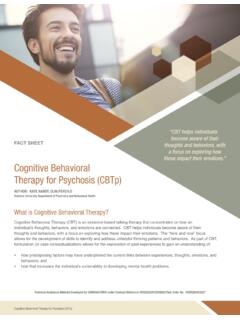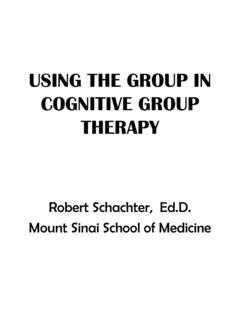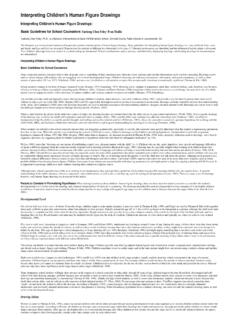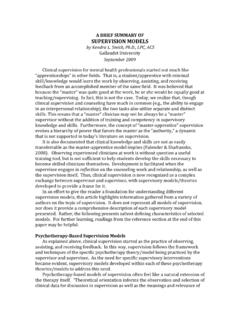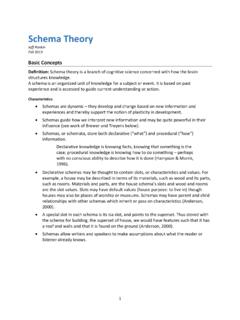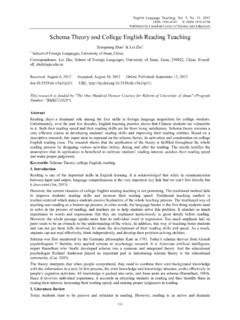Transcription of Using schemas and schema modes as a basis for formulation ...
1 Using schemas and schema modes as a basis forformulation and treatment planning in schema therapyDavid EdwardsCertified as a schema Therapist by the InternationalSociety of schema 3rd September 2013 schema therapy offers a comprehensive approach to addressing longstanding psychological difficulties. It is drawn from many of the discoveries about what is helpful in psychotherapy that have been madeover the past 100 years or so. It is an integrative approach to therapy developed by Jeffrey Young. Hebegan teaching trainees how to do schema therapy in the 1980s, and in due course publisheddescriptions of the approach for clinicians (Young, 1990; Young, Klosko and Weishaar, 2002) and forclients (Young & Klosko, 1994).
2 This document summarizes some of the important aspects of thisapproach to assessment and therapy . More information can be found on my website and on Jeff Young s website maladaptive schemasEarly maladaptive schemas (EMSs) are longstanding patterns of psychological response that governhow we perceive the world, how we understand what is happening to us, what we feel and how webehave. They often have their origins in infancy and early childhood and may even be set up before weare born (for example, if a traumatic event happened to our mother while she was pregnant). Sixfeatures of EMSs are identified by Young et al.
3 (2003, p. 7). An EMS a broad, pervasive theme or pattern .. comprised of memories, emotions, cognitions, and bodily sensations .. a regard of oneself and one's relationships with developed during childhood or adolescence .. elaborated throughout one's lifetime, and dysfunctional to a significant consequence of EMSs is that we behave in ways which are self-defeating or even self-destructive. These schema driven behaviours may be at the root of the emotional distress or problematicbehaviours that lead a person to seek psychotherapy. EMSs are automatic and habitual and typicallywe do not realize the impact they have on our relationships and our approach to work and otheraspects of life.
4 Because we may experience them as such an essential part of us, even when werecognize that they are problematic, we may feel helpless about changing schemas are responses to unmet needsAs infants and children, humans are vulnerable and helpless, and in order to develop in apsychologically healthy way, certain basic needs must be met. When basic needs are unmet, normal,healthy psychological development goes wrong and gives rise to EMSs that can continue to causeproblems throughout life if they are not addressed. The needs of the normal infant and child aresummarized below, with comments on the kinds of conditions under which they might not be The need for safety and stability: This need may not be met where children are born into unsafesituations: for example, into times of natural disasters (earthquake, tsunamis), or into neighbourhoodsor families where there is endemic violence.
5 2. The need for a secure, loving, and reliable bond with one or more caregivers: This need may not bemet if the mother or main caregiver is not a warm, loving person who enjoys giving maternal care, orwhere she becomes unavailable through illness, depression, or economic hardship, or if she isemotionally unstable or unpredictable, or in a family where there is abuse and The need to be supported over the course of growing up, in moving from helplessness anddependence to a sense of competence (to function in the world), autonomy (ability to make one s ownchoices). This need may not be met where need 1 is not met and children feel overwhelmed andunsafe in the world.
6 Similarly, it may not be met where caregivers fail to meet need 2 and fail to giveconsistent loving support to children as they venture out into the world and learn how it works. It willalso not be met where caregivers are overprotective or are attached to having children who aredependent and helpless and have difficulty letting them grow up and become The need to find appropriate expression for emotions and needs in a way that leads to needs beingmet. As children grow, if they have the right kind of loving support, they learn to identify and expresstheir feelings and needs in appropriate The need to learn how to flexibly manage and control one s emotional and behavioural reactions: This need may not be met when the need for safety and stability is not met, as children may experiencesuch extreme emotions that it is beyond their capacity to modulate them.
7 This need may not be metwhen the need for a stable loving relationship is not met, since learning to manage one s emotionstakes place in the interaction with a warm loving caregiver. Where parents are harsh and punitive,children may internalize their punitive voices as a means of maintaining The need to express oneself spontaneously, playfully and creatively: Playfulness and spontaneity arenormal features of human (and animal) behaviour, and with development, mature into warmth andcreativity. When these aspects of behaviour are neglected or actively discouraged or punished,individuals may lose their capacity for spontaneity and is considerable evidence that these needs are universal, and that, as Young suggests, apsychologically healthy individual is one who can adaptively get these core emotional needs met.
8 Once EMSs form as a result of unmet needs, they have the perverse effect of making it difficult for the2unmet needs to be met in the future. It is the aim of schema therapy to help people identify theirschemas, to understand how these relate to their unmet needs, and to help them find adaptive ways toget these needs met in their current lives. How early maladaptive schemas developYoung, Klosko and Weishaar (2003) describe how early life experiences give rise to EMSs: Toxic childhood experiences are the primary origin of early maladaptive schemas . Theschemas that develop earliest and are the strongest typically originate in the nuclearfamily.
9 To a large extent, the dynamics of a child's family are the dynamics of thatchild's entire early world. When patients find themselves in adult situations thatactivate their early maladaptive schemas , what they usually are experiencing is adrama from their childhood, usually with a parent. Other influences becomeincreasingly important as the child matures, such as peers, school, groups in thecommunity, and the surrounding culture, and may lead to the development ofschemas. However, schemas developed later are generally not as pervasive or aspowerful. These authors suggest that there are four kinds of experience which give rise to frustration of needs occurs when the child s basic needs for a stable loving relationshipand consistent care are not occurs when the child is harmed or victimized or exposed to traumaticsituations such as natural and overprotectiveness on the part of parents or caretakers prevent childrenfrom developing autonomy or appropriate of or identification with significant others results in children taking on thethoughts, feelings, experiences, and behaviors of their parents or caretakers.
10 For example,where a parent is punitive and critical, the child may become self-punitive and 18 early maladaptive schemas and the YSQC linical experience over several decades on the part of Young and his colleagues working with theschema therapy model has led to the development of a list of 18 early maladaptive schemas . This list(see appendix A) can be helpful, because each of these schemas is common and frequently contributesto the kinds of problems that lead people to seek psychotherapy. In helping you do identify theschemas which are affecting you and which may be contributing to your current difficulties, thetherapist will use a combination of sources of information.
